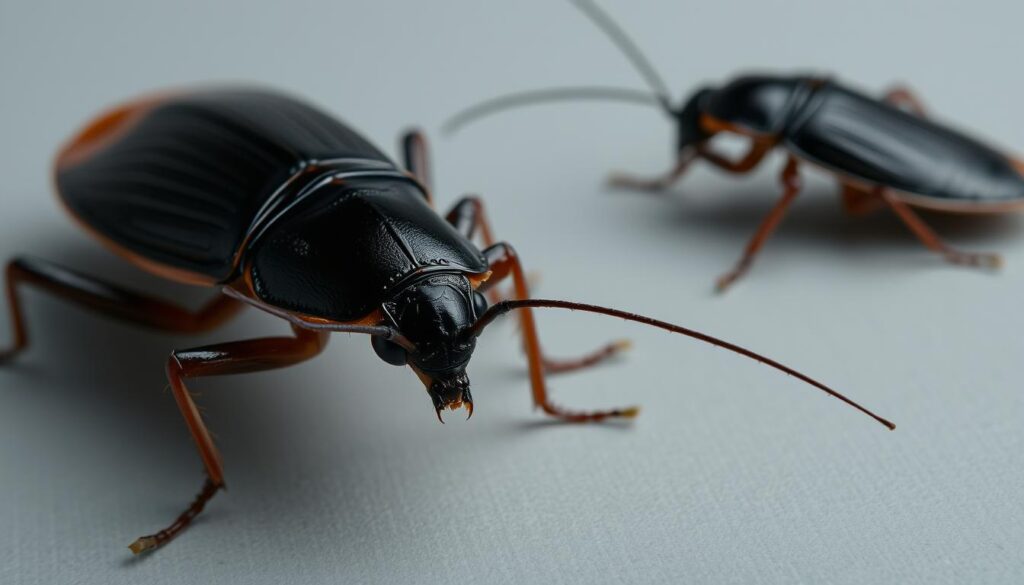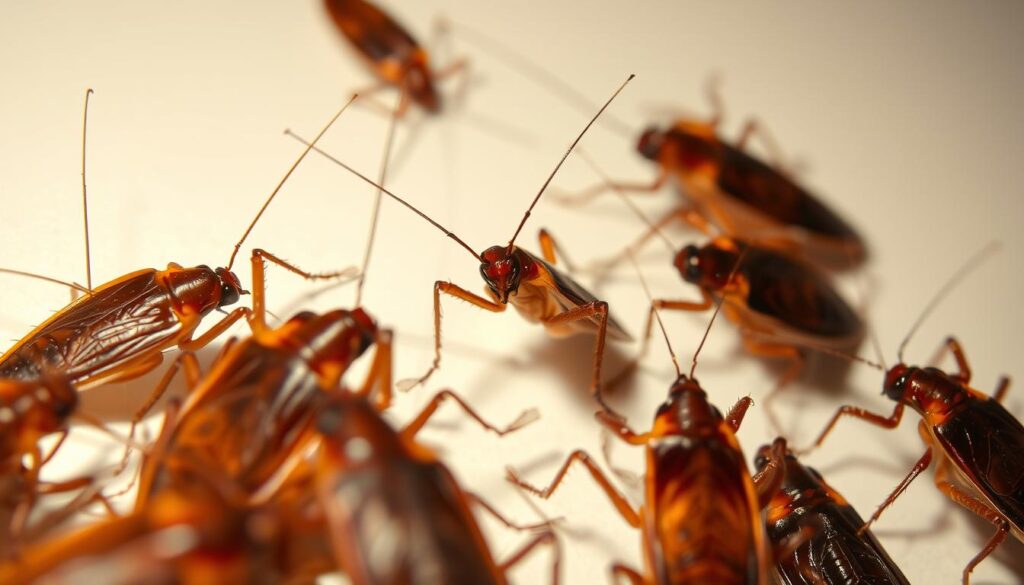Florida’s warm and humid climate is perfect for many roach species. Did you know Florida has some of the most common and troublesome cockroaches in the U.S.? With over 50 species of cockroaches in the state, it can be hard to identify and manage these pests.
Knowing the different Florida roach species is key for good pest control. The American Cockroach, German Cockroach, and Australian Cockroach are among the most common. Each has its own look and behavior.
Key Takeaways
- Florida is home to over 50 species of cockroaches.
- Common roach species in Florida include the American, German, and Australian Cockroaches.
- Understanding the characteristics of each species is key to effective pest control.
- Proper identification is crucial for managing roach infestations.
- Prevention tips can help reduce the risk of roach infestations in homes and businesses.
Overview of Roaches in Florida
Florida has many roach species. Each needs its own way to be identified and controlled. Knowing about these pests is key to managing them well.
Importance of Identifying Roaches
First, you must know what kind of roach you have. Different roaches like different things. Some like wet places, others like food.
Accurate identification helps you use the right control methods. This way, you can stop infestations and avoid using harmful pesticides. It’s not just about killing the roaches you see. It’s about knowing where they live and why they’re there.
“The key to managing roach infestations lies in understanding their behavior and ecological preferences.” – Pest Control Expert
Typical Environments for Roaches
Roaches live in many places, like homes, gardens, and public areas. They love warm, wet places. Florida is perfect for them.
| Environment | Common Roach Species | Conditions Favoring Infestation |
|---|---|---|
| Homes | German Cockroach, American Cockroach | Food availability, moisture |
| Gardens | Smokybrown Cockroach, Oriental Cockroach | Organic matter, shelter |
| Public Places | American Cockroach, German Cockroach | Food waste, humidity |
To stop roaches, know where they like to be. Keep your place clean, dry, and sealed. This helps a lot.
Common Types of Roaches in Florida
Florida’s warm and humid weather is perfect for many cockroach breeds. But, do you know which roach you’re facing? Knowing the different Florida roach varieties is key to controlling pests.
American Cockroach
The American Cockroach is huge, growing up to 2 inches long. They are reddish-brown with a yellow band on their back.
German Cockroach
German Cockroaches are smaller, about 0.5 to 0.6 inches long. They are light brown or tan with two dark stripes. They breed fast and live in kitchens and bathrooms.
Smokybrown Cockroach
Smokybrown Cockroaches are dark brown to black, about 1 to 1.3 inches long. They love light and are often near windows and outdoor lights.
Oriental Cockroach
Oriental Cockroaches are big, about 1 to 1.25 inches long, and dark brown or black. They like cool, damp places and are found in basements and crawl spaces.
For more info on these cockroaches, check out Catseye Pest Control. They have detailed info on Florida’s cockroach types.
| Cockroach Type | Size | Color | Preferred Habitat |
|---|---|---|---|
| American Cockroach | 1.5 – 2 inches | Reddish-brown | Warm, humid areas |
| German Cockroach | 0.5 – 0.6 inches | Light brown/tan | Kitchens, bathrooms |
| Smokybrown Cockroach | 1 – 1.3 inches | Dark brown/black | Near windows, outdoor lighting |
| Oriental Cockroach | 1 – 1.25 inches | Dark brown/black | Cool, damp areas |
American Cockroach: Characteristics and Behavior
The American cockroach is one of the biggest roach species in Florida. It loves humid places. You can find it in homes, gardens, and sewers. It’s known for its reddish-brown color and big size.
Physical Appearance
The American cockroach is really big, growing up to 2 inches long. It has a reddish-brown body with a yellow band on its back. It has wings but doesn’t fly much.
Habitats and Nesting Preferences
American cockroaches like warm, humid places. They’re found in basements, sewers, and where it’s wet. They love food, especially old, rotting stuff.
They nest in dark spots like under sinks and near water heaters. They also live outside in gardens and under leaves.
Common Myths
Many people think American cockroaches mean a house is dirty. But they can get into clean homes too. They just need a way in and the right place to live.
Some think they spread diseases. But they don’t carry diseases to people often. Still, they can make allergies and asthma worse.
Comparison of Cockroach Species in Florida
| Species | Size | Color | Preferred Habitat |
|---|---|---|---|
| American Cockroach | 1.4 – 2 inches | Reddish-brown | Humid, warm environments |
| German Cockroach | 0.5 – 0.6 inches | Light brown to tan | Indoor, near food and water |
| Smokybrown Cockroach | 1 – 1.4 inches | Dark brown to mahogany | Outdoor, trees, and vegetation |
German Cockroach: Characteristics and Behavior
The German cockroach is a common pest in Florida. It reproduces quickly and adapts well to different places. Knowing its traits helps manage infestations.
Distinct Identification Marks
German cockroaches are smaller, about 1/2 to 5/8 inch long. They are light brown to tan with two dark stripes on their back. These distinctive markings help identify them.
Reproduction and Lifecycle
German cockroaches reproduce fast. Females can have up to 50 eggs in each case. From egg to adult, they can grow in just 30 days.
| Stage | Duration | Description |
|---|---|---|
| Egg | 3-4 weeks | Eggs are carried by the female until they are ready to hatch. |
| Nymph | 4-6 weeks | Nymphs go through several molts before reaching adulthood. |
| Adult | Several months | Adults reproduce, continuing the cycle. |
Preferred Living Conditions
German cockroaches love warm, humid places. Florida is perfect for them. They live in kitchens and bathrooms where food and moisture are easy to find.
“German cockroaches are a significant pest in Florida due to their ability to spread disease and trigger allergies. Understanding their behavior is crucial for effective control measures.”
To prevent infestations, keep things clean and dry. Also, seal any entry points. This helps manage German cockroach problems.
Smokybrown Cockroach: Characteristics and Behavior
The Smokybrown Cockroach is special in Florida’s cockroach world. It has unique traits. Knowing its behavior helps fight pests.
Identification Features
The Smokybrown Cockroach has a dark brown, shiny shell. It’s big and can fly. Its dark brown color helps spot it among others.
Behavior and Habitat
Smokybrown Cockroaches live outside in gardens and under leaves. They like moist places. They fly well and are drawn to light, sometimes entering homes.
Noteworthy Facts
Smokybrown Cockroaches love moist places. They thrive in humid areas with lots of organic matter. Knowing this helps keep them away from homes.
In summary, the Smokybrown Cockroach is unique in Florida. It flies and prefers moist outdoor spots. Understanding it helps manage its presence.
Oriental Cockroach: Characteristics and Behavior
In Florida, knowing about the roach identification is key. The Oriental cockroach is a common pest. It likes damp, humid places.
This cockroach is dark brown or black and moves slowly. It loves moist spots like basements and sewers. Knowing how it acts helps in controlling pests.
Appearance and Size Comparison
Oriental cockroaches are big, about 1 inch long. They are shiny and dark. Males have wings that cover about ¾ of their body, while females have very short, stubby wings, making them less likely to fly.

Natural Habitat
Oriental cockroaches like damp, cool places. They live in basements, crawl spaces, and sewers. They also like areas around drains and near water leaks.
In Florida, they’re more common in humid, hot spots. They don’t like dry, well-ventilated areas.
Seasonal Activity Patterns
Oriental cockroaches are active all year in Florida’s warm climate. But they’re most active in warm, humid months. They invade homes and buildings during heavy rain or when their habitats flood.
Knowing when they’re most active helps in pest control. Regular checks and keeping areas dry can prevent infestations.
Roach Infestation Signs
Finding roach infestations early is important. It helps stop them from spreading and keeps us healthy. Roaches can cause allergies and asthma, so spotting them is key.
Visual Indicators
Seeing roaches is a clear sign of an infestation. They might be on your counters, floors, or near food, especially at night. Look out for:
- Roach droppings, which look like coffee grounds or black pepper
- Egg shells or eggs
- Live roaches or dead bodies
Sounds and Smells
Roaches make sounds and smells too. Some species make noise while they search for food. A strong, bad smell is another sign. This smell is often musty or oily.
Health Risks Associated
Roach infestations are serious. They can spread diseases, cause allergies, and make asthma worse. If you see signs, act fast. For help getting rid of cockroaches in Florida, visit https://www.ondemandpestcontrol.com/get-rid-of-cockroaches-in-florida/.
| Signs | Description | Health Risk |
|---|---|---|
| Visual Sightings | Live or dead roaches | Allergies, Asthma |
| Droppings | Coffee ground-like or black pepper-like | Disease transmission |
| Unpleasant Odors | Musty or oily smells | Respiratory issues |
Prevention Tips for Florida Residents
To stop roach problems in Florida, keep your home clean and well-maintained. Know about the roaches in your area. This way, you can lower the chance of roaches showing up.
Maintaining Clean Environments
Keeping your home clean is a top way to stop roaches. They like food, water, and places to hide. So, get rid of these things to keep them away. Here are some tips:
- Regularly clean up crumbs and spills
- Store food in sealed containers
- Take out the trash regularly
- Clean under appliances and around sinks
Cleanliness is key to stopping roach problems. A clean, clutter-free home makes it less likely for roaches to come in.
Seal Off Entry Points
Roaches can get into tiny spaces. So, it’s important to seal off entry points. Look for gaps or holes and seal them with caulk or steel wool. Check areas like:
- Pipes and plumbing fixtures
- Windows and doors
- Electrical outlets and switches
Landscaping Considerations
Your yard can also help prevent roach problems. A clean yard means fewer roaches near your home. Think about these tips:
| Landscaping Tip | Benefit |
|---|---|
| Keep vegetation trimmed back from your home | Reduces hiding places for roaches |
| Remove debris and clutter from your yard | Eliminates potential roach habitats |
| Use mulch and wood chips judiciously | Can help reduce moisture that attracts roaches |
By following these tips, you can lower the chance of roaches in your Florida home. Remember, roach identification in Florida helps you know what to watch out for and how to act.
Effective Roach Management Strategies
Managing roach infestations in Florida needs a mix of DIY and professional help. It’s important to know the different ways to tackle roach problems.
DIY Control Methods
DIY methods are a good start to fight roach infestations. They include keeping things clean, sealing holes, and using traps or baits. Proper sanitation helps stop roaches by removing food they like.
Some DIY methods are:
- Regular cleaning and less clutter
- Sealing holes around windows, doors, and pipes
- Using roach baits or traps where you see roaches
Professional Pest Control Options
For big roach problems, professional pest control services are needed. They have the tools and know-how to find and treat the source.
Professional pest control offers many benefits:
| Service | Description | Benefits |
|---|---|---|
| Inspection | Thorough check of the property to find roach spots and entry points | Finds the main cause of the problem |
| Treatment | Using special pesticides to kill roaches | Gets rid of roach problems |
| Prevention | Advice and treatments to stop future problems | Keeps roaches away for a long time |
When to Seek Expert Help
It’s key to know when to call a pro for roach problems. If you see lots of roaches, roach eggs, or DIY methods don’t work, it’s time to call a professional.

Using DIY methods and professional help when needed helps manage roach problems in Florida. This keeps your home healthy and roach-free.
Impact of Climate on Roach Populations
Florida’s subtropical climate is perfect for many roach species. The state’s high humidity and warm temperatures help roaches grow. It’s key to know how climate affects their numbers.
Florida’s Humidity and Temperature Effects
Roaches love Florida’s climate. High humidity keeps them from drying out. And the warm temperatures make them breed faster.
This mix of humidity and heat makes roach numbers go up. So, people in Florida often see more roaches, especially when it’s warm and humid for a long time.
Seasonal Variations in Roach Activity
Roaches are active all year in Florida, but their activity changes with the seasons. Warmer months are best for them to live and have babies. In the cooler months, they might slow down, but they never stop.
Knowing when roaches are most active helps fight them. By understanding these patterns, people can stop roaches before they start. This helps keep everyone healthier.
Understanding Roach Behavior in Florida
Knowing how roaches act in Florida helps stop them from taking over. Roaches are not just pests; they have complex ways of living. Understanding these behaviors can help us control their numbers.
Nocturnal Habits
Roaches are mostly active at night. This helps them find food and mate without being seen.
By day, they hide in dark spots like under appliances or in cabinets. Knowing they are night creatures helps us find where they hide and stop them.
Feeding Preferences
Roaches eat almost anything, from food to paper. Some, like the American cockroach, will eat almost anything they find.
In Florida, where food is plentiful, roaches can easily find what they need. Keeping your place clean and food stored right can keep them away.
Social Behavior and Interaction
Roaches also have complex social lives. Some live in big groups. They use chemical signals, or pheromones, to talk to each other.
| Behavior | Description | Management Tip |
|---|---|---|
| Nocturnal Habits | Active at night, hiding during the day | Seal hiding spots and use night lights to monitor |
| Feeding Preferences | Omnivores, feeding on various materials | Maintain cleanliness and store food properly |
| Social Behavior | Form aggregations guided by pheromones | Use traps that exploit pheromone signals |
By learning about roach behavior, we can fight them better in Florida. Cleanliness, sealing up holes, and using traps are all good ways to keep them away. Knowing how roaches act is key to winning the battle against them.
Conclusion: Staying Roach-Free in Florida
To keep Florida roach-free, you need to know about different roach types and their habits. Learning about common Florida roaches helps you prevent them.
Key Takeaways
We talked about Florida’s main roach types: American, German, Smokybrown, and Oriental cockroaches. Each has its own traits and ways of living. This affects where they show up in your place.
Ongoing Prevention
Keeping your place roach-free is a constant job. It means keeping things clean, sealing up holes, and watching your yard. Being careful and acting fast helps avoid roach problems.
Knowing about Florida’s roaches and preventing them helps us all. Keeping our spaces clean and pest-free is a team effort. It’s about paying attention and staying ready to stop roaches.



















